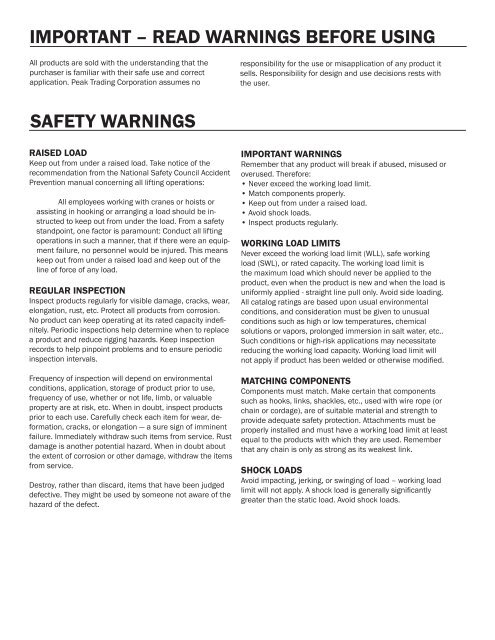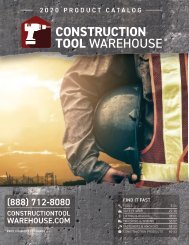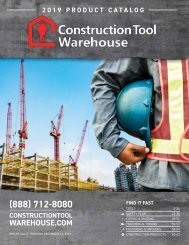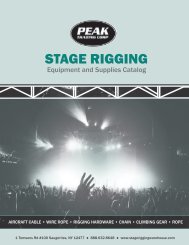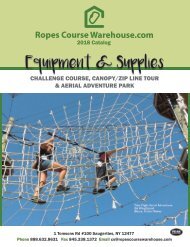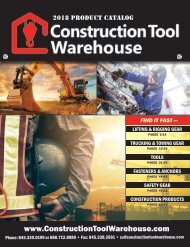Peak Catalog
We carry high quality Wire Rope, Aircraft Cable, Chain, Fittings, Rigging Equipment, Lifting Products, Rope, Climbing Gear, Fall Protection, Tie-Down Equipment, Hand Tools and much more.
We carry high quality Wire Rope, Aircraft Cable, Chain, Fittings, Rigging Equipment, Lifting Products, Rope, Climbing Gear, Fall Protection, Tie-Down Equipment, Hand Tools and much more.
You also want an ePaper? Increase the reach of your titles
YUMPU automatically turns print PDFs into web optimized ePapers that Google loves.
IMPORTANT – READ WARNINGS BEFORE USING<br />
All products are sold with the understanding that the<br />
purchaser is familiar with their safe use and correct<br />
application. <strong>Peak</strong> Trading Corporation assumes no<br />
responsibility for the use or misapplication of any product it<br />
sells. Responsibility for design and use decisions rests with<br />
the user.<br />
SAFETY WARNINGS<br />
RAISED LOAD<br />
Keep out from under a raised load. Take notice of the<br />
recommendation from the National Safety Council Accident<br />
Prevention manual concerning all lifting operations:<br />
All employees working with cranes or hoists or<br />
assisting in hooking or arranging a load should be instructed<br />
to keep out from under the load. From a safety<br />
standpoint, one factor is paramount: Conduct all lifting<br />
operations in such a manner, that if there were an equipment<br />
failure, no personnel would be injured. This means<br />
keep out from under a raised load and keep out of the<br />
line of force of any load.<br />
REGULAR INSPECTION<br />
Inspect products regularly for visible damage, cracks, wear,<br />
elongation, rust, etc. Protect all products from corrosion.<br />
No product can keep operating at its rated capacity indefinitely.<br />
Periodic inspections help determine when to replace<br />
a product and reduce rigging hazards. Keep inspection<br />
records to help pinpoint problems and to ensure periodic<br />
inspection intervals.<br />
Frequency of inspection will depend on environmental<br />
conditions, application, storage of product prior to use,<br />
frequency of use, whether or not life, limb, or valuable<br />
property are at risk, etc. When in doubt, inspect products<br />
prior to each use. Carefully check each item for wear, deformation,<br />
cracks, or elongation — a sure sign of imminent<br />
failure. Immediately withdraw such items from service. Rust<br />
damage is another potential hazard. When in doubt about<br />
the extent of corrosion or other damage, withdraw the items<br />
from service.<br />
Destroy, rather than discard, items that have been judged<br />
defective. They might be used by someone not aware of the<br />
hazard of the defect.<br />
IMPORTANT WARNINGS<br />
Remember that any product will break if abused, misused or<br />
overused. Therefore:<br />
• Never exceed the working load limit.<br />
• Match components properly.<br />
• Keep out from under a raised load.<br />
• Avoid shock loads.<br />
• Inspect products regularly.<br />
WORKING LOAD LIMITS<br />
Never exceed the working load limit (WLL), safe working<br />
load (SWL), or rated capacity. The working load limit is<br />
the maximum load which should never be applied to the<br />
product, even when the product is new and when the load is<br />
uniformly applied - straight line pull only. Avoid side loading.<br />
All catalog ratings are based upon usual environmental<br />
conditions, and consideration must be given to unusual<br />
conditions such as high or low temperatures, chemical<br />
solutions or vapors, prolonged immersion in salt water, etc..<br />
Such conditions or high-risk applications may necessitate<br />
reducing the working load capacity. Working load limit will<br />
not apply if product has been welded or otherwise modified.<br />
MATCHING COMPONENTS<br />
Components must match. Make certain that components<br />
such as hooks, links, shackles, etc., used with wire rope (or<br />
chain or cordage), are of suitable material and strength to<br />
provide adequate safety protection. Attachments must be<br />
properly installed and must have a working load limit at least<br />
equal to the products with which they are used. Remember<br />
that any chain is only as strong as its weakest link.<br />
SHOCK LOADS<br />
Avoid impacting, jerking, or swinging of load – working load<br />
limit will not apply. A shock load is generally significantly<br />
greater than the static load. Avoid shock loads.


